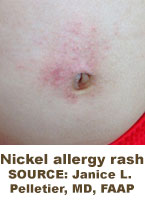For children allergic to nickel, anything from jeans with metal buttons to handheld electronics can cause a red, itchy rash. Called nickel-allergic contact dermatitis, an
allergy to nickel affects an estimated 1.1 million children in the United States.
An allergy to nickel is not life-threatening, but it can be uncomfortable enough to get in the way of a child's
sleep and cause them to
miss school. Sometimes, an allergic reaction to nickel is mistaken for an infection, especially near broken skin like a pierced ear. The allergy also has been linked to severe hand
eczema later in adulthood.
What does an allergic reaction to nickel look like?
 The skin allergic reaction to nickel looks like eczema. Signs and symptoms include an itchy rash with redness, swelling, scaling and possibly a crusty appearance. The rash generally appears on the area of the skin that comes into contact with the metal. If the metal exposure is ongoing, sometimes a rash may show up in more distant parts of the body. Once children become sensitive to nickel, gradually worsening rashes may develop each time they are exposed to nickel again.
The skin allergic reaction to nickel looks like eczema. Signs and symptoms include an itchy rash with redness, swelling, scaling and possibly a crusty appearance. The rash generally appears on the area of the skin that comes into contact with the metal. If the metal exposure is ongoing, sometimes a rash may show up in more distant parts of the body. Once children become sensitive to nickel, gradually worsening rashes may develop each time they are exposed to nickel again.
How to help prevent nickel allergy reactions
Although there is no cure for nickel allergy, here are a few ways to help prevent reactions:
Clothing & accessories. Avoid clothing with metal buttons, snaps, rivets and zippers. Look for belts, watches and jewelry and other accessories that are labeled "nickel-free," or buy items that are hypoallergenic are or made of surgical-grade stainless steel, gold, silver, or platinum.
Cover or coat surfaces. Sew a piece of cloth over the metal to prevent direct contact with skin. It may also help to put two coats of clear nail polish on metal that touches skin. This is not an ideal solution, since nail polish can chip off and needs to be touched up--especially after washings.
Electronic devices. Place a nickel-free case around your child's tablet or phone that covers the parts made of metal.
Coins & keys. Advise your child not to keep loose coins and keys in pockets.
Seating. Avoid sitting on metal chairs or plastic chairs with metal tabs while wearing shorts.
Ear piercing & braces. Avoid ear piercing, at least until after a child is past the age when they might get braces. This helps prevent sensitization to nickel that can get worse while wearing metal braces. If your child does get pierced ears, choose posts that are nickel-free or made of surgical grade steel that is less likely to release nickel. It is also a good idea to wear plastic posts until the skin heals from piercing.
Cosmetics. Cosmetics and other beauty products that contain metal should be avoided. Nickel allergy has been linked with nail polish from a bottle that contains nickel metal shaker balls.
Foods & cooking. Particularly if a child has a known nickel allergy, it might be useful to avoid foods that contain nickel. This includes chocolate, nuts, soy products, black tea, seeds, and commercial salad dressings. Choose fresh or frozen rather than canned food when possible. Don't use stainless steel pots and pans to cook acidic foods that contain acidic ingredients like tomato, vinegar, or lemon.
Tap water. Run tap water for a few seconds before washing, drinking, and cooking to help flush out any nickel that can leach from pipes and fixtures.
Tattoo ink. Teens and young adults who are allergic to nickel should use extra caution if they are considering getting
tattoos, since some inks contain nickel.
Treatment for nickel allergy
In addition to recommending ways to help avoid exposure to nickel, your pediatrician may recommend short-term treatment with a steroid ointment or another anti-inflammatory medication.
More Information